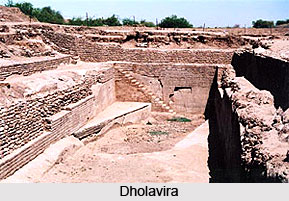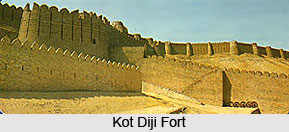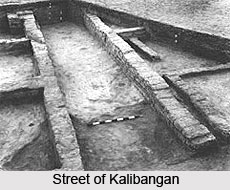 Since the first discovery of this civilization in 1920-21 at Harappa in the Indus Valley, hundreds of sites spread over more than a million square kilometres in the Indian subcontinent have been excavated, many of these are in Northern and Western India. Geographically, it was spread over an area of some 1,260,000 km, comprising the whole of modern day Pakistan and parts of modern-day India and Afghanistan. To date, over 1,052 cities and settlements have been found, mainly in the banks of the Ghaggar-Hakra River and its tributaries. The major urban centers of the Indus valley civilizations were Harappa, Mohenjo-daro, Lothal, Dholavira, Ganweriwala, Kalibanga, Banwalli etc.
Since the first discovery of this civilization in 1920-21 at Harappa in the Indus Valley, hundreds of sites spread over more than a million square kilometres in the Indian subcontinent have been excavated, many of these are in Northern and Western India. Geographically, it was spread over an area of some 1,260,000 km, comprising the whole of modern day Pakistan and parts of modern-day India and Afghanistan. To date, over 1,052 cities and settlements have been found, mainly in the banks of the Ghaggar-Hakra River and its tributaries. The major urban centers of the Indus valley civilizations were Harappa, Mohenjo-daro, Lothal, Dholavira, Ganweriwala, Kalibanga, Banwalli etc.
The Indus Valley Civilization was extended from Baluchistan to Gujarat, with an upward reach to the Punjab from east of River Jhelum to Rupar on the upper Sutlej. The coast settlements extended from Sutkagan Dor at Iranian border to Lothal in Gujarat. The following are some of the important sites of Harappan civilization:
 Kotdiji:
Kotdiji:
Kot Diji, 40 km east of Mohen-jo-Daro on the left bank, is one of the earliest known fortified city. It was a startling discovery which gave new evidence of pre-Harappan culture and pushed back Pakistan`s history by another 500 years. It was an important site in Sindh having a citadel and the lower town. It had defensive wall with a mud brick revetment in the exterior with bastions and the inner face was enforced at intervals with a stone revetment bounded with stone courses at the bottom.
Naushero:
The site of Naushero, located six km away from Mehargarh had developed Kotdijian settlement. Blocks of mud houses divided by roads and streets were found during the excavation. The typical Indus pottery was associated with the monumental structures of Indus culture. , Historians were found many large sized structures of mud bricks and platforms and a 7.25 m wide wall. In comparison to Daborkot, it was a smaller settlement but sharing fully the developmental process towards maturity of urbanization.
Kalibangan:
This pre-historic town is located 205 Km from Bikaner. Kalibangann, literally means `black bangles`. It got its name from the myraid pieces of terracotta bangles excavated here. Kalibangan was an early Harappan fortified settlement, having houses on both sides of streets, brick on edge platforms, bathrooms and drains of baked bricks. In the succeeding Harappan period, Kalibangan had a citadel in the west and fortified chessboard patterned city in the east. The citadel had an impressive gateway in the south with a flight of steps to climb up to the platforms. The citadel was divided into two parts, i.e., one having platforms and other having a residential complex for the elite, separated by a wall. The site had a cemetery. Between 2600 and 1900 BC, Kalibangan witnessed about nine reconstructions.
Banawali:
Banawali Mound previously called Vanawali, lies 14 kms, north-west of Fatehbad on the right bank of the Rangoi Nala, This ancient mound spread over an area of one sq. km., rose to a height of about 10 meters due to successive settlements on the earlier rubble.
The archaeological excavations have revealed a well-constructed fort town of the Harappan period overlying an extensive proto-urban settlement of the pre-Harappan culture. If the discovered ancient relics are pieced together, a fairly coherent picture emerges and it can be conjured up that if Kalibangan was a metropolitan town over the lower middle valley of the Saraswati, Banawali was possibly one over the upper middle course of that river. The civilization seems to have been conversant with the technology of copper smelting. Among personal ornaments, beads of gold, semi-precious stones, terracotta and steatite and bangles of clay, shell, faience and copper have been. recovered during the course of excavation.
 Lothal:
Lothal:
Lothal, one of the most interesting remnants of the ancient Harappan civilisation, is situated in Gujarat. The unique dockyard is perhaps the greatest of maritime architecture from the ancient world.
The citadel was obviously separated an acropolis, with its own paved baths, and a lower town more humble residential quarters, coppersmithing workshops, sheds and bead factories. The whole system exhibited an excellent of sanitary drainage. A museum was also discovered. The archaeological findings offered an insight into the Indus Valley period.
The Lower City
The Indus Valley Civilisation at Lothal was a trade centre for the Indus valley civilisation when it moved down from Sindh to theSaurashtra coast. Rangpur and Lothal, were among the first two places where the Indus valley civilisation was discovered in India. While this proves that the Harrapans had maritime tendencies, depended on water sources for their survival and navigated rivers and sea water for trade and communication, none of these ancient cities became a major scientific port like Lothal.
It is believed that Lothal was the site of the Red Ware culture, named for its vivacious pottery, until 2400 BC when the Harappans arrived here from the Indus Valley in search of more fertile lands and potential ports. Gradually they colonised many areas along the Gulf of Cambay, forming citadels that include the southernmost outpost of the Indus Valley civilization, which spanned an area larger than those of the Nile Valley civilization and Mesopatamian civilization.
 The Dockyard
The Dockyard
Lothal developed as the most important port and a centre of the bead industry until 1900 B.C. A long wharf connected the dockyard to the main warehouse, which was located on a plinth of some 3.5 meters above the ground. The whole town was situated on a patch of high ground, rising up from the flat alluvial plains of Bhal, a wall was erected to encircle the town and a platform was built for the warehouse where goods were checked and stored.
The warehouse was divided into 64 rooms of around 3 1/2 sq meters each, connected by 1.2 meter wide passages, and 12 of these cubical blocks are visible even today. Seals were used to label the imports and exports from the dock, and some of these labels have been found during digs. Klin fired bricks, which the Harrapans had learnt from experience were unaffected by tidal waters, were used in making passages to protect the cargo. The ruler`s home was no longer a grand palace, but the foundations showed signs of it having been a 2/3 storeyed mansion. The rooms of the upper town were obviously built for ruling classes, as they had private paved baths, and a remarkable network of drains and cess pools. The proximity of the seat of power to the warehouse, ensured that the ruler and his entourage could inspect stocks easily.
Surkotada:
It is located 160 km., northeast of Bhuj, in Rann of Kacch. Surkotada had a citadel and a fortified residential annexe. The citadel had an imposing gateway complex. It was built over a platform. The entrance to the citadel was provided with a ramp, barbican, steps and guard rooms. "The site had a cemetery. A common 7m. thick wall with an opening, separated the citadel and the Lower Town.
 Dholavira:
Dholavira:
Of all the harappan sites the site of Dholavira locally known as kotada, is in the Khadir island of Kutch. It is remarkable for its magnificent planning and enormity of area and deposit. The latest excavations at Dholavira measures about 600m. on the north-south axis and 775 m. on the east-west. Inside the general fortification, there are three distinct complexes-An Acropolis, a middle town and a lower town, the first two of them strongly fortified. The acropolis was provided with one gate at each side. Of the two gates, one each on the east and north are exposed and found furnished with a flight of steps, a sunken passageway flanked by elevated chambers, and a high front terrace-a remarkably elaborate layout. Further, use of highly polished stone-blocks and pillars along the passage-may speak of architectural achievement without parallel at any Indus site so far. In the centre of the citadel, there is an almost 13 m wide water reservoir along with a feeder channel covered with slabs and provided with manholes for occasional desilting. Besides, there are two lapidary workshops. The most outstanding discovery is the find of a large sized inscription of ten Harappan signs which may be a signboard.
Rojdi:
The excavation at Rojdi, besides the discovery of imposing architecture e.g, fortification, gateway, the large square build in and houses built of stone rubble has given new insight in the evolution of Harappan Culture of Saurashtra which the excavators feel is a "newly discovered regional expression of the Harappan urban phase appears to be an addition to the settlement type and evolutionary process in Saurashtra.
Kuntasi:
The Harappan site Kuntasi, seven km from the Gulf of Kutch, (District Rajkot), was basically not an agricultural settlement but appears to have been a centre for procuring raw materials and processing them into finished products primarily for exporting them to Sindh and West Asia. In Kuntasi a mound measuring 150 by 125 metres and four metres high, has been found to be a trading settlement, as the archeologists have found remains of a landing platform 30 metres long, warehouses and workshops. The settlement was a port and a manufacturing centre. The Harappans of Kuntasi manufactured pottery, copper articles, bangles and beads made of agate and carnellian and lapis lazuli, the last of which was brought to Kuntasi as a raw material from Badakshan in Afghanistan. Large interconnected rooms for workers, a large common kitchen and workshops have led to the theory that Kuntasi was not a regular Harappan settlement but meant to house artisans who crafted the wares.



















